heating FORD F750 2013 12.G Owners Manual
[x] Cancel search | Manufacturer: FORD, Model Year: 2013, Model line: F750, Model: FORD F750 2013 12.GPages: 378, PDF Size: 3.82 MB
Page 3 of 378
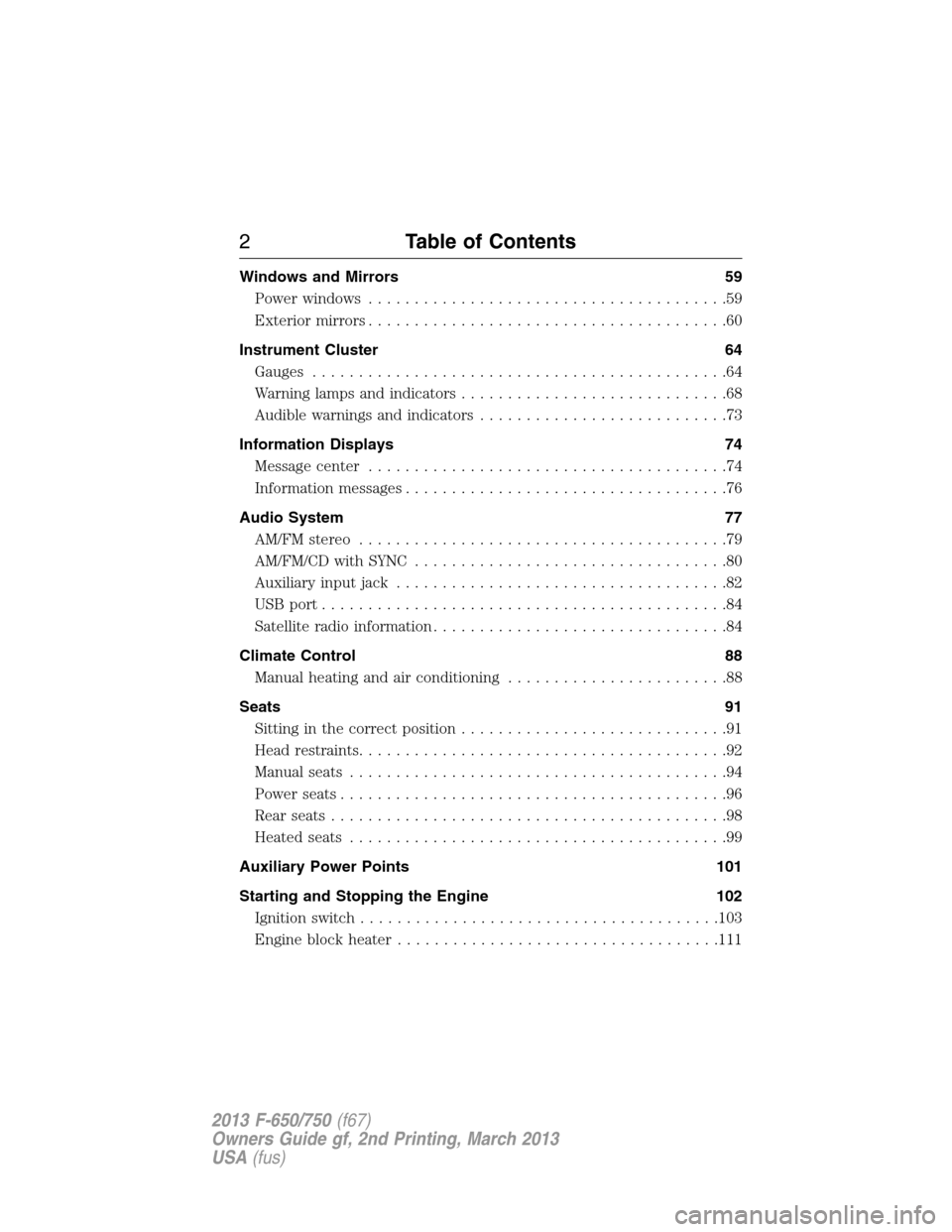
Windows and Mirrors 59
Power windows.......................................59
Exteriormirrors.......................................60
Instrument Cluster 64
Gauges.............................................64
Warning lamps and indicators.............................68
Audible warnings and indicators...........................73
Information Displays 74
Message center.......................................74
Information messages...................................76
Audio System 77
AM/FMstereo ........................................79
AM/FM/CD with SYNC..................................80
Auxiliary input jack....................................82
USB port............................................84
Satellite radio information................................84
Climate Control 88
Manual heating and air conditioning........................88
Seats 91
Sitting in the correct position.............................91
Head restraints........................................92
Manual seats.........................................94
Power seats..........................................96
Rear seats...........................................98
Heated seats.........................................99
Auxiliary Power Points 101
Starting and Stopping the Engine 102
Ignition switch.......................................103
Engine block heater...................................111
2Table of Contents
2013 F-650/750(f67)
Owners Guide gf, 2nd Printing, March 2013
USA(fus)
Page 63 of 378
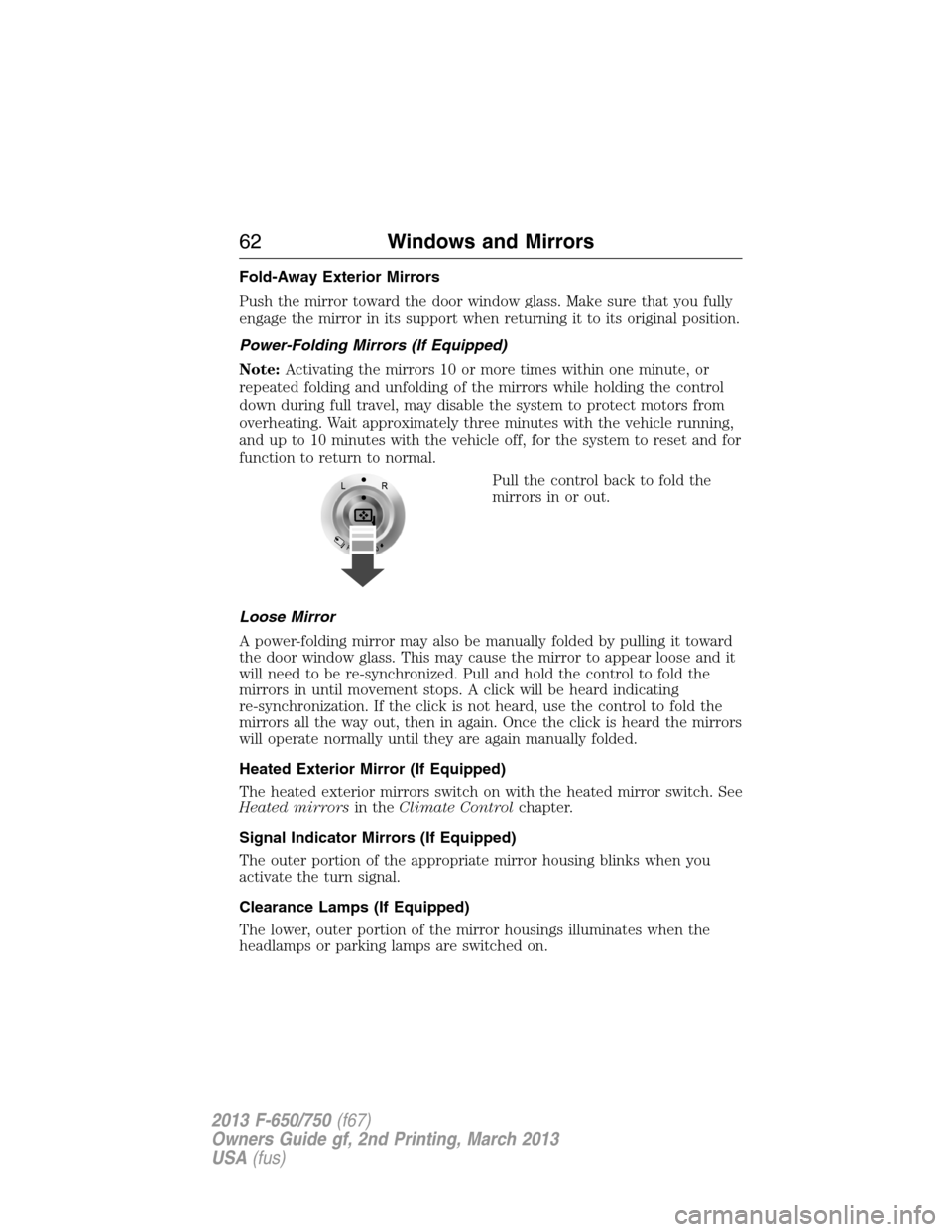
Fold-Away Exterior Mirrors
Push the mirror toward the door window glass. Make sure that you fully
engage the mirror in its support when returning it to its original position.
Power-Folding Mirrors (If Equipped)
Note:Activating the mirrors 10 or more times within one minute, or
repeated folding and unfolding of the mirrors while holding the control
down during full travel, may disable the system to protect motors from
overheating. Wait approximately three minutes with the vehicle running,
and up to 10 minutes with the vehicle off, for the system to reset and for
function to return to normal.
Pull the control back to fold the
mirrors in or out.
Loose Mirror
A power-folding mirror may also be manually folded by pulling it toward
the door window glass. This may cause the mirror to appear loose and it
will need to be re-synchronized. Pull and hold the control to fold the
mirrors in until movement stops. A click will be heard indicating
re-synchronization. If the click is not heard, use the control to fold the
mirrors all the way out, then in again. Once the click is heard the mirrors
will operate normally until they are again manually folded.
Heated Exterior Mirror (If Equipped)
The heated exterior mirrors switch on with the heated mirror switch. See
Heated mirrorsin theClimate Controlchapter.
Signal Indicator Mirrors (If Equipped)
The outer portion of the appropriate mirror housing blinks when you
activate the turn signal.
Clearance Lamps (If Equipped)
The lower, outer portion of the mirror housings illuminates when the
headlamps or parking lamps are switched on.
62Windows and Mirrors
2013 F-650/750(f67)
Owners Guide gf, 2nd Printing, March 2013
USA(fus)
Page 100 of 378
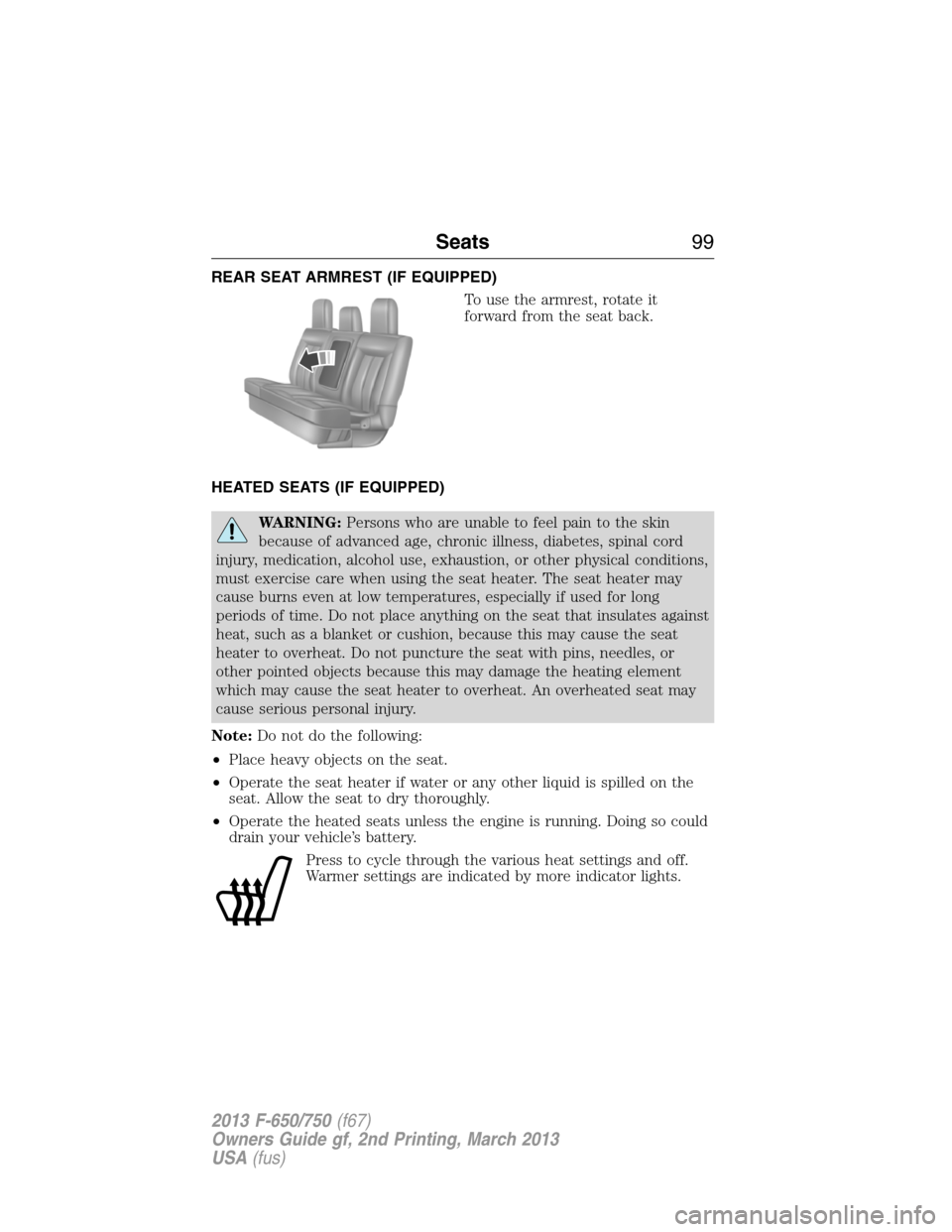
REAR SEAT ARMREST (IF EQUIPPED)
To use the armrest, rotate it
forward from the seat back.
HEATED SEATS (IF EQUIPPED)
WARNING:Persons who are unable to feel pain to the skin
because of advanced age, chronic illness, diabetes, spinal cord
injury, medication, alcohol use, exhaustion, or other physical conditions,
must exercise care when using the seat heater. The seat heater may
cause burns even at low temperatures, especially if used for long
periods of time. Do not place anything on the seat that insulates against
heat, such as a blanket or cushion, because this may cause the seat
heater to overheat. Do not puncture the seat with pins, needles, or
other pointed objects because this may damage the heating element
which may cause the seat heater to overheat. An overheated seat may
cause serious personal injury.
Note:Do not do the following:
•Place heavy objects on the seat.
•Operate the seat heater if water or any other liquid is spilled on the
seat. Allow the seat to dry thoroughly.
•Operate the heated seats unless the engine is running. Doing so could
drain your vehicle’s battery.
Press to cycle through the various heat settings and off.
Warmer settings are indicated by more indicator lights.
Seats99
2013 F-650/750(f67)
Owners Guide gf, 2nd Printing, March 2013
USA(fus)
Page 116 of 378
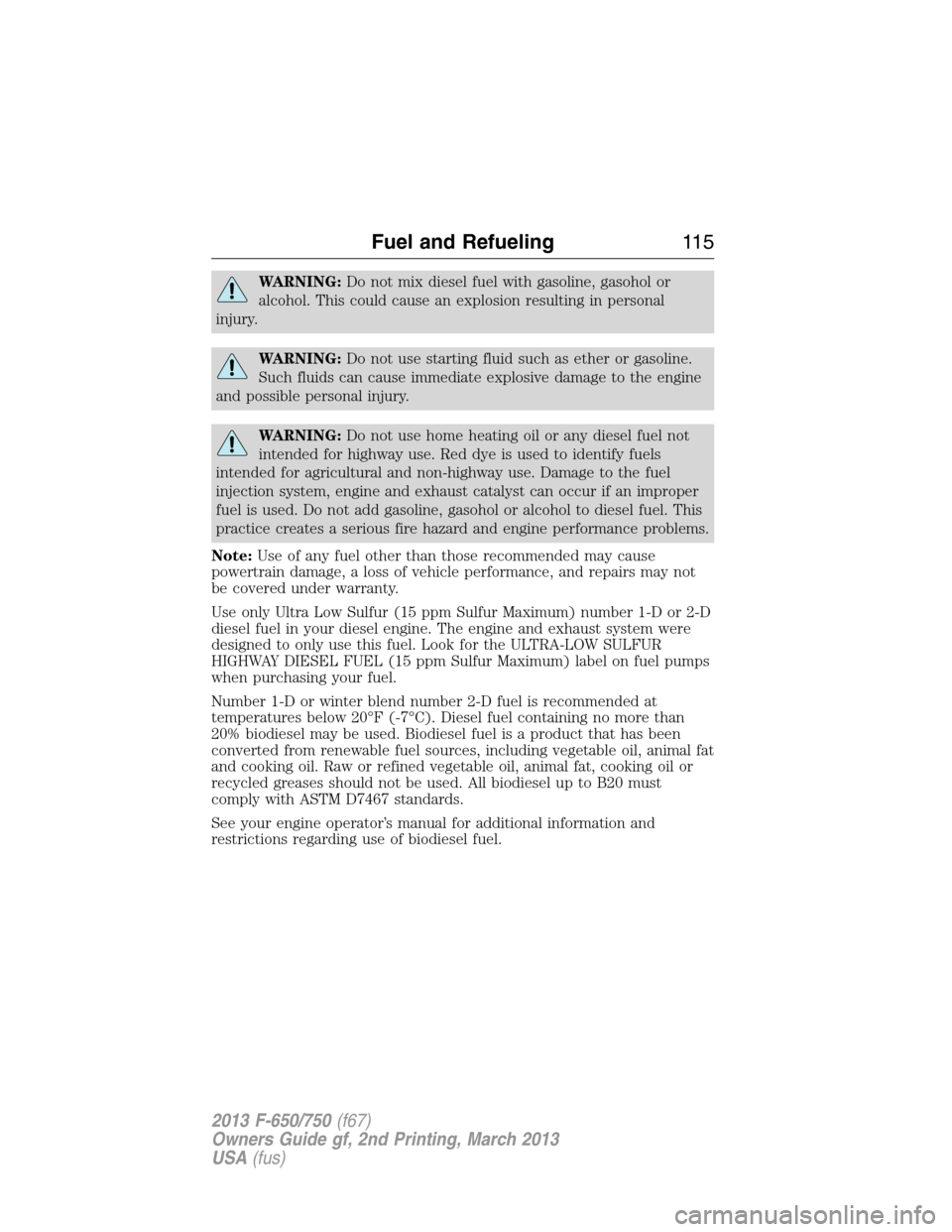
WARNING:Do not mix diesel fuel with gasoline, gasohol or
alcohol. This could cause an explosion resulting in personal
injury.
WARNING:Do not use starting fluid such as ether or gasoline.
Such fluids can cause immediate explosive damage to the engine
and possible personal injury.
WARNING:Do not use home heating oil or any diesel fuel not
intended for highway use. Red dye is used to identify fuels
intended for agricultural and non-highway use. Damage to the fuel
injection system, engine and exhaust catalyst can occur if an improper
fuel is used. Do not add gasoline, gasohol or alcohol to diesel fuel. This
practice creates a serious fire hazard and engine performance problems.
Note:Use of any fuel other than those recommended may cause
powertrain damage, a loss of vehicle performance, and repairs may not
be covered under warranty.
Use only Ultra Low Sulfur (15 ppm Sulfur Maximum) number 1-D or 2-D
diesel fuel in your diesel engine. The engine and exhaust system were
designed to only use this fuel. Look for the ULTRA-LOW SULFUR
HIGHWAY DIESEL FUEL (15 ppm Sulfur Maximum) label on fuel pumps
when purchasing your fuel.
Number 1-D or winter blend number 2-D fuel is recommended at
temperatures below 20°F (-7°C). Diesel fuel containing no more than
20% biodiesel may be used. Biodiesel fuel is a product that has been
converted from renewable fuel sources, including vegetable oil, animal fat
and cooking oil. Raw or refined vegetable oil, animal fat, cooking oil or
recycled greases should not be used. All biodiesel up to B20 must
comply with ASTM D7467 standards.
See your engine operator’s manual for additional information and
restrictions regarding use of biodiesel fuel.
Fuel and Refueling11 5
2013 F-650/750(f67)
Owners Guide gf, 2nd Printing, March 2013
USA(fus)
Page 131 of 378
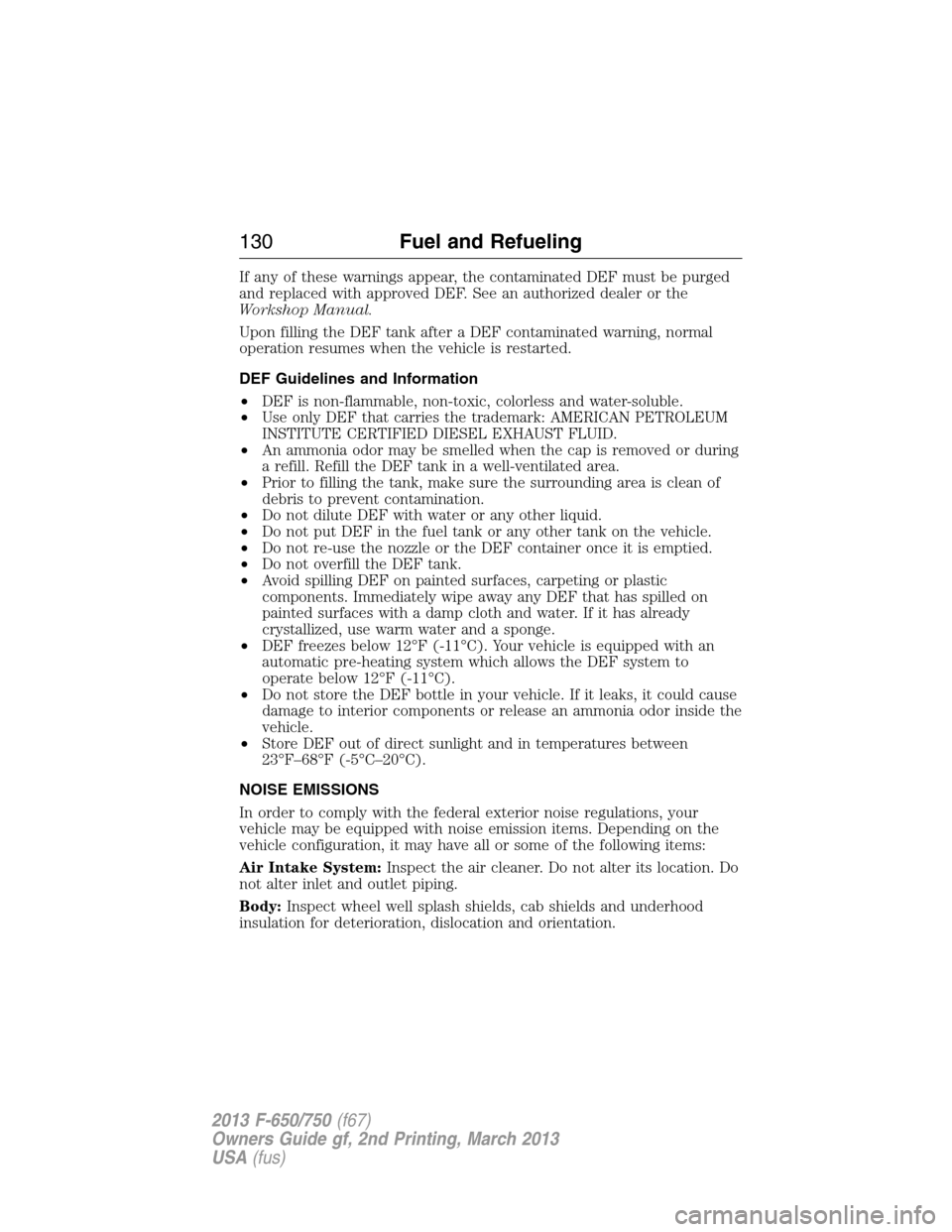
If any of these warnings appear, the contaminated DEF must be purged
and replaced with approved DEF. See an authorized dealer or the
Workshop Manual.
Upon filling the DEF tank after a DEF contaminated warning, normal
operation resumes when the vehicle is restarted.
DEF Guidelines and Information
•DEF is non-flammable, non-toxic, colorless and water-soluble.
•Use only DEF that carries the trademark: AMERICAN PETROLEUM
INSTITUTE CERTIFIED DIESEL EXHAUST FLUID.
•An ammonia odor may be smelled when the cap is removed or during
a refill. Refill the DEF tank in a well-ventilated area.
•Prior to filling the tank, make sure the surrounding area is clean of
debris to prevent contamination.
•Do not dilute DEF with water or any other liquid.
•Do not put DEF in the fuel tank or any other tank on the vehicle.
•Do not re-use the nozzle or the DEF container once it is emptied.
•Do not overfill the DEF tank.
•Avoid spilling DEF on painted surfaces, carpeting or plastic
components. Immediately wipe away any DEF that has spilled on
painted surfaces with a damp cloth and water. If it has already
crystallized, use warm water and a sponge.
•DEF freezes below 12°F (-11°C). Your vehicle is equipped with an
automatic pre-heating system which allows the DEF system to
operate below 12°F (-11°C).
•Do not store the DEF bottle in your vehicle. If it leaks, it could cause
damage to interior components or release an ammonia odor inside the
vehicle.
•Store DEF out of direct sunlight and in temperatures between
23°F–68°F (-5°C–20°C).
NOISE EMISSIONS
In order to comply with the federal exterior noise regulations, your
vehicle may be equipped with noise emission items. Depending on the
vehicle configuration, it may have all or some of the following items:
Air Intake System:Inspect the air cleaner. Do not alter its location. Do
not alter inlet and outlet piping.
Body:Inspect wheel well splash shields, cab shields and underhood
insulation for deterioration, dislocation and orientation.
130Fuel and Refueling
2013 F-650/750(f67)
Owners Guide gf, 2nd Printing, March 2013
USA(fus)
Page 171 of 378
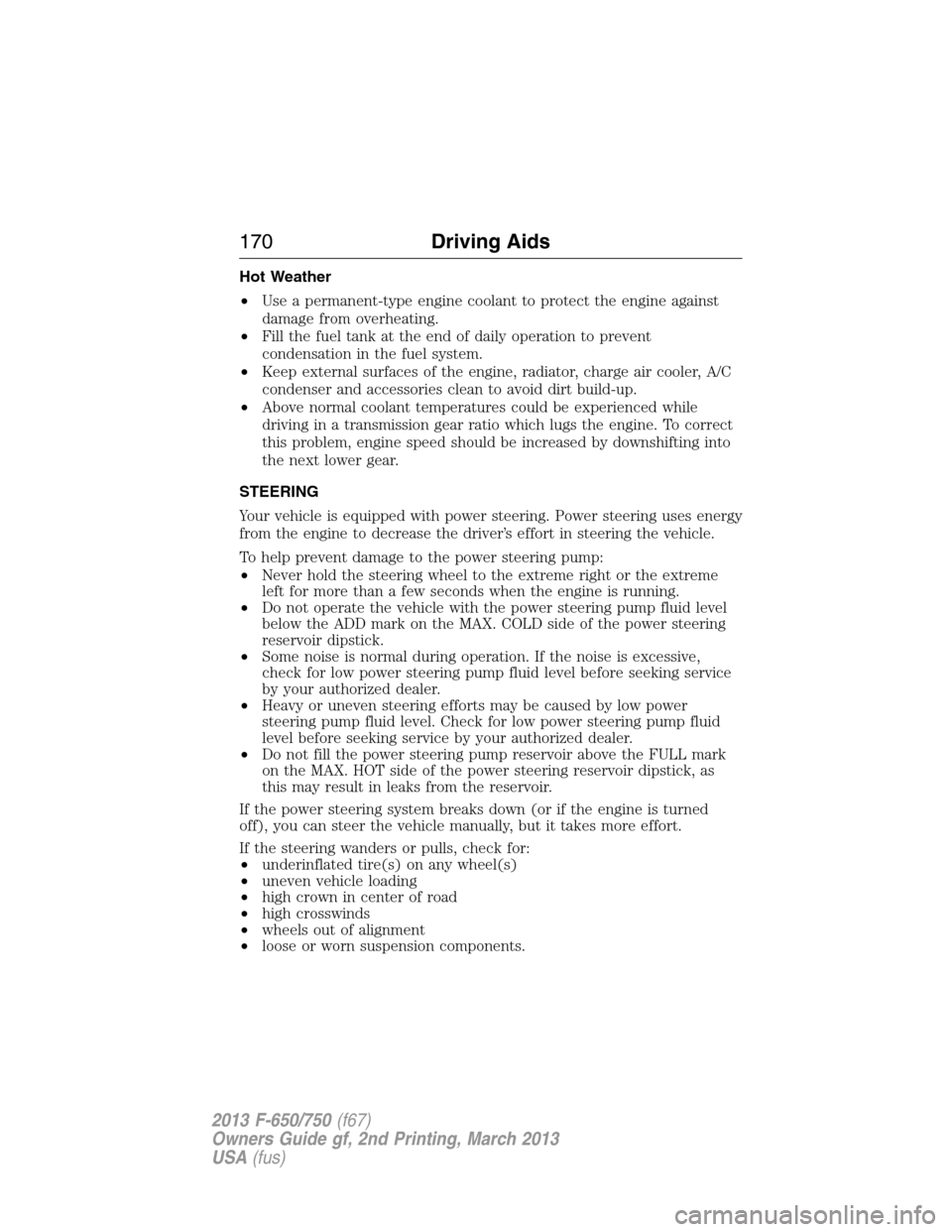
Hot Weather
•Use a permanent-type engine coolant to protect the engine against
damage from overheating.
•Fill the fuel tank at the end of daily operation to prevent
condensation in the fuel system.
•Keep external surfaces of the engine, radiator, charge air cooler, A/C
condenser and accessories clean to avoid dirt build-up.
•Above normal coolant temperatures could be experienced while
driving in a transmission gear ratio which lugs the engine. To correct
this problem, engine speed should be increased by downshifting into
the next lower gear.
STEERING
Your vehicle is equipped with power steering. Power steering uses energy
from the engine to decrease the driver’s effort in steering the vehicle.
To help prevent damage to the power steering pump:
•Never hold the steering wheel to the extreme right or the extreme
left for more than a few seconds when the engine is running.
•Do not operate the vehicle with the power steering pump fluid level
below the ADD mark on the MAX. COLD side of the power steering
reservoir dipstick.
•Some noise is normal during operation. If the noise is excessive,
check for low power steering pump fluid level before seeking service
by your authorized dealer.
•Heavy or uneven steering efforts may be caused by low power
steering pump fluid level. Check for low power steering pump fluid
level before seeking service by your authorized dealer.
•Do not fill the power steering pump reservoir above the FULL mark
on the MAX. HOT side of the power steering reservoir dipstick, as
this may result in leaks from the reservoir.
If the power steering system breaks down (or if the engine is turned
off), you can steer the vehicle manually, but it takes more effort.
If the steering wanders or pulls, check for:
•underinflated tire(s) on any wheel(s)
•uneven vehicle loading
•high crown in center of road
•high crosswinds
•wheels out of alignment
•loose or worn suspension components.
170Driving Aids
2013 F-650/750(f67)
Owners Guide gf, 2nd Printing, March 2013
USA(fus)
Page 221 of 378
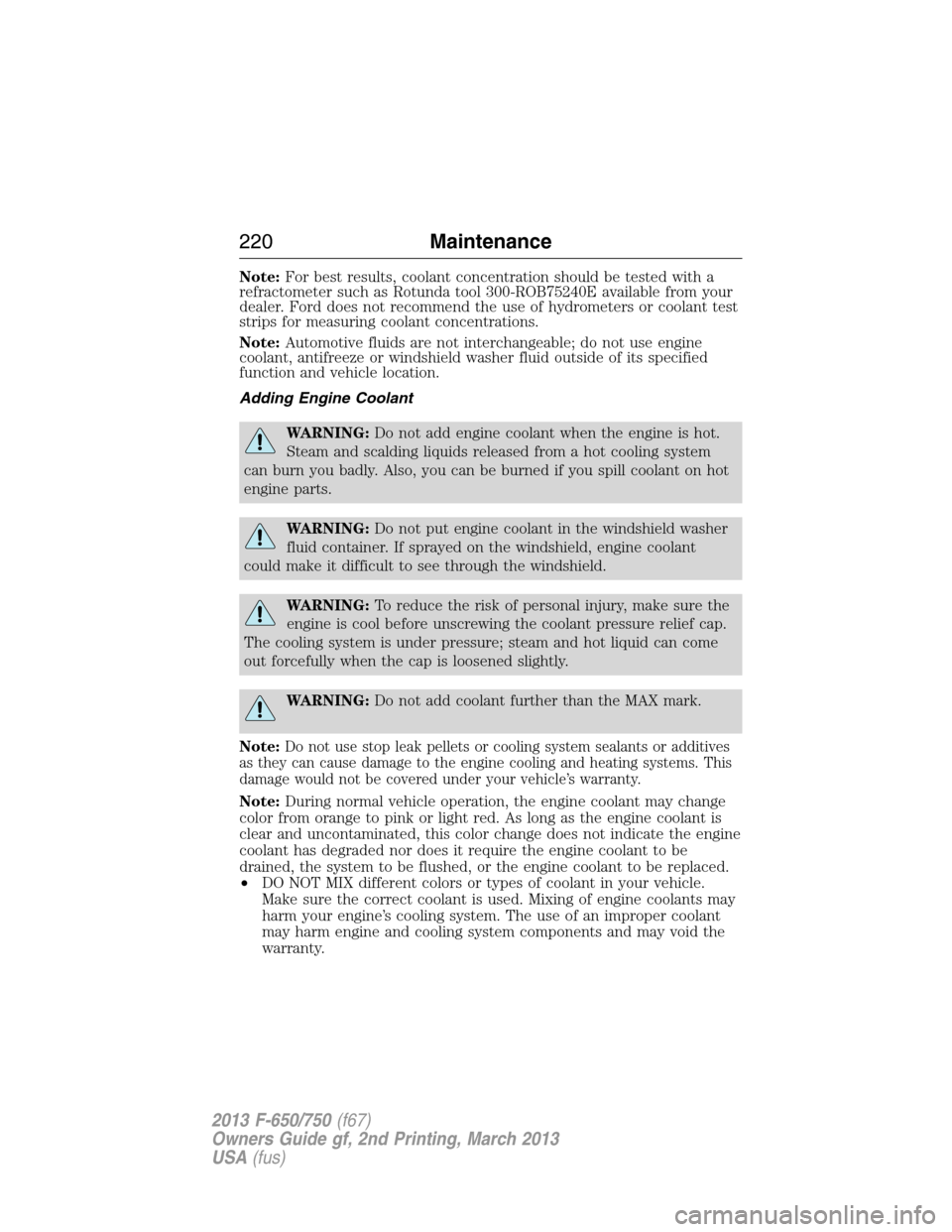
Note:For best results, coolant concentration should be tested with a
refractometer such as Rotunda tool 300-ROB75240E available from your
dealer. Ford does not recommend the use of hydrometers or coolant test
strips for measuring coolant concentrations.
Note:Automotive fluids are not interchangeable; do not use engine
coolant, antifreeze or windshield washer fluid outside of its specified
function and vehicle location.
Adding Engine Coolant
WARNING:Do not add engine coolant when the engine is hot.
Steam and scalding liquids released from a hot cooling system
can burn you badly. Also, you can be burned if you spill coolant on hot
engine parts.
WARNING:Do not put engine coolant in the windshield washer
fluid container. If sprayed on the windshield, engine coolant
could make it difficult to see through the windshield.
WARNING:To reduce the risk of personal injury, make sure the
engine is cool before unscrewing the coolant pressure relief cap.
The cooling system is under pressure; steam and hot liquid can come
out forcefully when the cap is loosened slightly.
WARNING:Do not add coolant further than the MAX mark.
Note:
Do not use stop leak pellets or cooling system sealants or additives
as they can cause damage to the engine cooling and heating systems. This
damage would not be covered under your vehicle’s warranty.
Note:During normal vehicle operation, the engine coolant may change
color from orange to pink or light red. As long as the engine coolant is
clear and uncontaminated, this color change does not indicate the engine
coolant has degraded nor does it require the engine coolant to be
drained, the system to be flushed, or the engine coolant to be replaced.
•DO NOT MIX different colors or types of coolant in your vehicle.
Make sure the correct coolant is used. Mixing of engine coolants may
harm your engine’s cooling system. The use of an improper coolant
may harm engine and cooling system components and may void the
warranty.
220Maintenance
2013 F-650/750(f67)
Owners Guide gf, 2nd Printing, March 2013
USA(fus)
Page 222 of 378
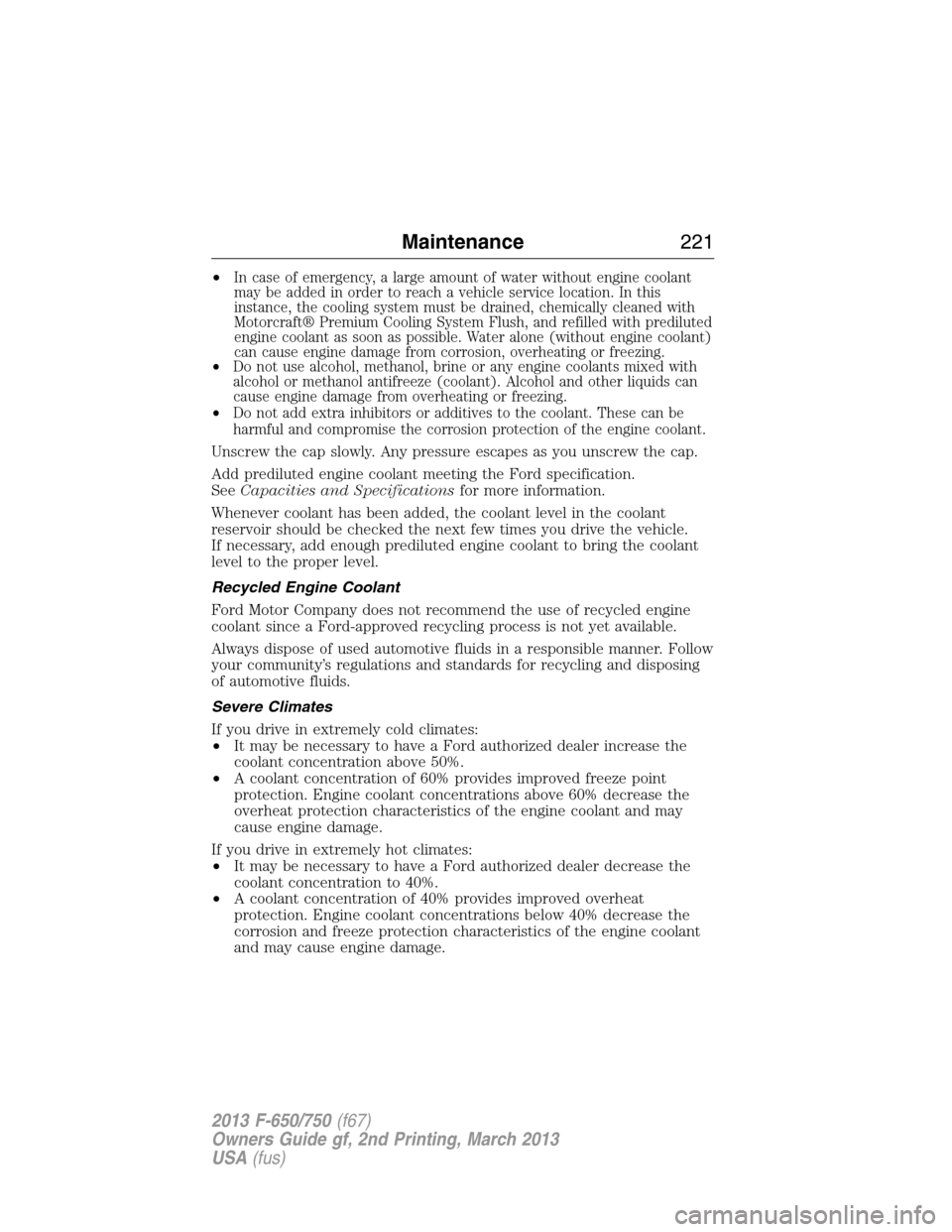
•In case of emergency, a large amount of water without engine coolant
may be added in order to reach a vehicle service location. In this
instance, the cooling system must be drained, chemically cleaned with
Motorcraft® Premium Cooling System Flush, and refilled with prediluted
engine coolant as soon as possible. Water alone (without engine coolant)
can cause engine damage from corrosion, overheating or freezing.
•Do not use alcohol, methanol, brine or any engine coolants mixed with
alcohol or methanol antifreeze (coolant). Alcohol and other liquids can
cause engine damage from overheating or freezing.
•Do not add extra inhibitors or additives to the coolant. These can be
harmful and compromise the corrosion protection of the engine coolant.
Unscrew the cap slowly. Any pressure escapes as you unscrew the cap.
Add prediluted engine coolant meeting the Ford specification.
SeeCapacities and Specificationsfor more information.
Whenever coolant has been added, the coolant level in the coolant
reservoir should be checked the next few times you drive the vehicle.
If necessary, add enough prediluted engine coolant to bring the coolant
level to the proper level.
Recycled Engine Coolant
Ford Motor Company does not recommend the use of recycled engine
coolant since a Ford-approved recycling process is not yet available.
Always dispose of used automotive fluids in a responsible manner. Follow
your community’s regulations and standards for recycling and disposing
of automotive fluids.
Severe Climates
If you drive in extremely cold climates:
•It may be necessary to have a Ford authorized dealer increase the
coolant concentration above 50%.
•A coolant concentration of 60% provides improved freeze point
protection. Engine coolant concentrations above 60% decrease the
overheat protection characteristics of the engine coolant and may
cause engine damage.
If you drive in extremely hot climates:
•It may be necessary to have a Ford authorized dealer decrease the
coolant concentration to 40%.
•A coolant concentration of 40% provides improved overheat
protection. Engine coolant concentrations below 40% decrease the
corrosion and freeze protection characteristics of the engine coolant
and may cause engine damage.
Maintenance221
2013 F-650/750(f67)
Owners Guide gf, 2nd Printing, March 2013
USA(fus)
Page 223 of 378
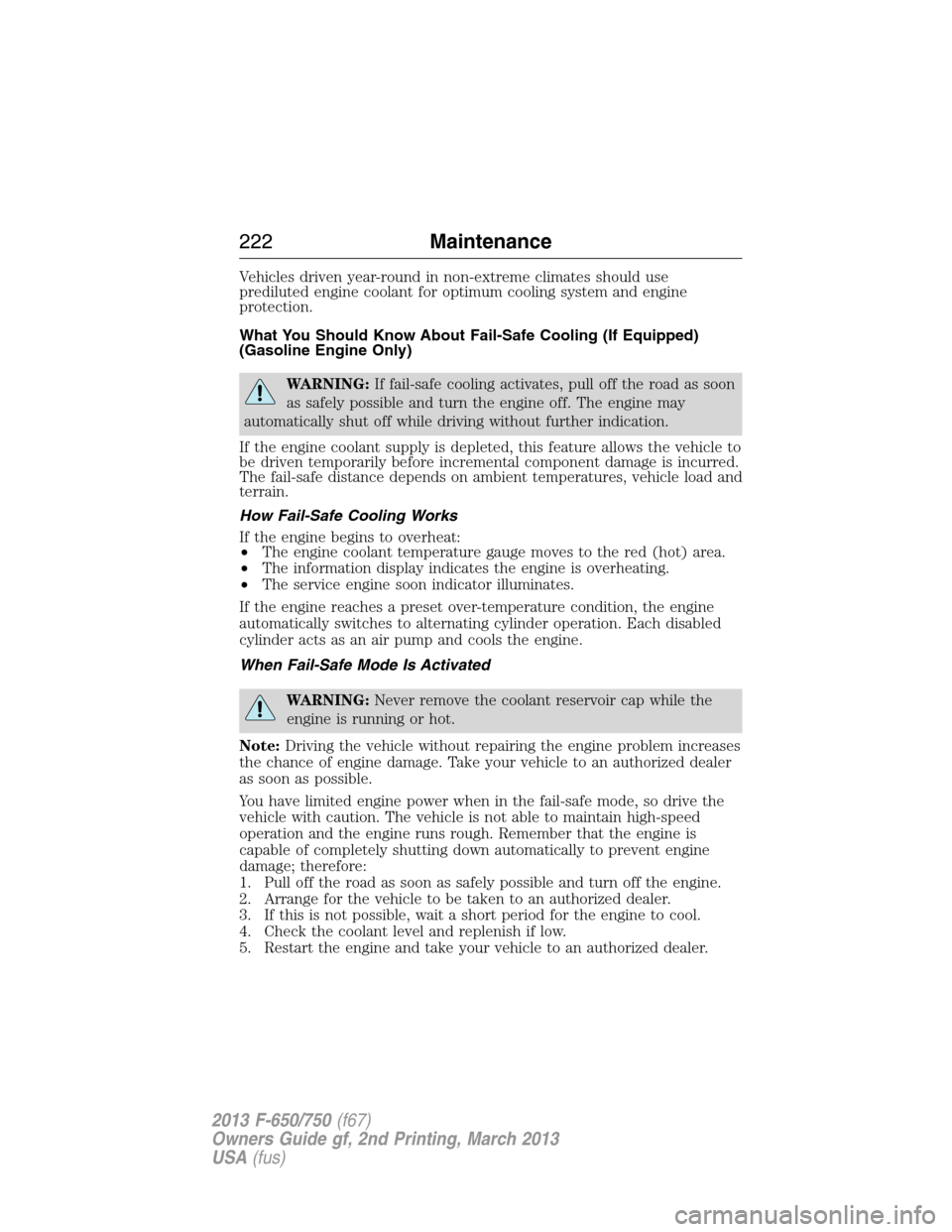
Vehicles driven year-round in non-extreme climates should use
prediluted engine coolant for optimum cooling system and engine
protection.
What You Should Know About Fail-Safe Cooling (If Equipped)
(Gasoline Engine Only)
WARNING:If fail-safe cooling activates, pull off the road as soon
as safely possible and turn the engine off. The engine may
automatically shut off while driving without further indication.
If the engine coolant supply is depleted, this feature allows the vehicle to
be driven temporarily before incremental component damage is incurred.
The fail-safe distance depends on ambient temperatures, vehicle load and
terrain.
How Fail-Safe Cooling Works
If the engine begins to overheat:
•The engine coolant temperature gauge moves to the red (hot) area.
•The information display indicates the engine is overheating.
•The service engine soon indicator illuminates.
If the engine reaches a preset over-temperature condition, the engine
automatically switches to alternating cylinder operation. Each disabled
cylinder acts as an air pump and cools the engine.
When Fail-Safe Mode Is Activated
WARNING:Never remove the coolant reservoir cap while the
engine is running or hot.
Note:Driving the vehicle without repairing the engine problem increases
the chance of engine damage. Take your vehicle to an authorized dealer
as soon as possible.
You have limited engine power when in the fail-safe mode, so drive the
vehicle with caution. The vehicle is not able to maintain high-speed
operation and the engine runs rough. Remember that the engine is
capable of completely shutting down automatically to prevent engine
damage; therefore:
1. Pull off the road as soon as safely possible and turn off the engine.
2. Arrange for the vehicle to be taken to an authorized dealer.
3. If this is not possible, wait a short period for the engine to cool.
4. Check the coolant level and replenish if low.
5. Restart the engine and take your vehicle to an authorized dealer.
222Maintenance
2013 F-650/750(f67)
Owners Guide gf, 2nd Printing, March 2013
USA(fus)
Page 226 of 378
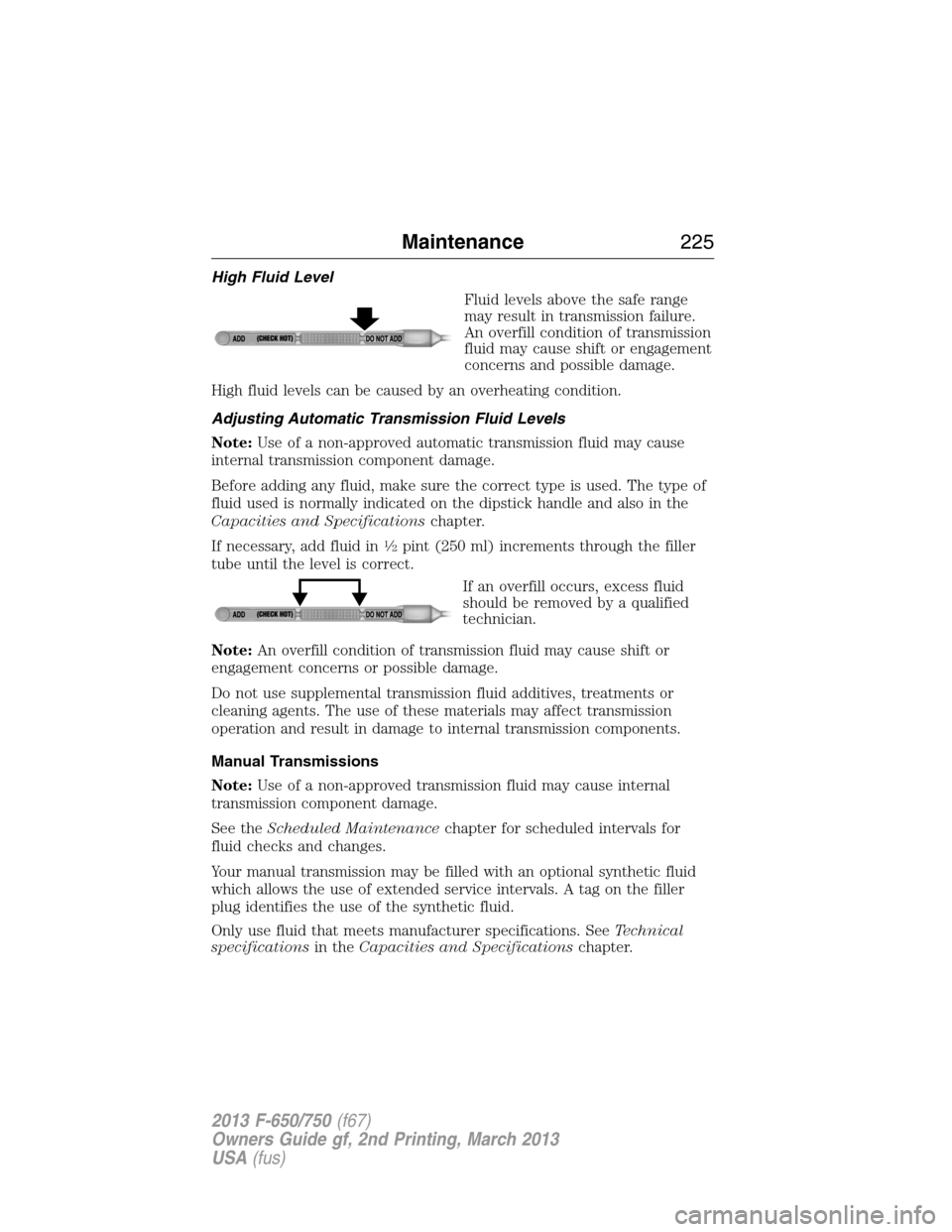
High Fluid Level
Fluid levels above the safe range
may result in transmission failure.
An overfill condition of transmission
fluid may cause shift or engagement
concerns and possible damage.
High fluid levels can be caused by an overheating condition.
Adjusting Automatic Transmission Fluid Levels
Note:Use of a non-approved automatic transmission fluid may cause
internal transmission component damage.
Before adding any fluid, make sure the correct type is used. The type of
fluid used is normally indicated on the dipstick handle and also in the
Capacities and Specificationschapter.
If necessary, add fluid in
1�2pint (250 ml) increments through the filler
tube until the level is correct.
If an overfill occurs, excess fluid
should be removed by a qualified
technician.
Note:An overfill condition of transmission fluid may cause shift or
engagement concerns or possible damage.
Do not use supplemental transmission fluid additives, treatments or
cleaning agents. The use of these materials may affect transmission
operation and result in damage to internal transmission components.
Manual Transmissions
Note:Use of a non-approved transmission fluid may cause internal
transmission component damage.
See theScheduled Maintenancechapter for scheduled intervals for
fluid checks and changes.
Your manual transmission may be filled with an optional synthetic fluid
which allows the use of extended service intervals. A tag on the filler
plug identifies the use of the synthetic fluid.
Only use fluid that meets manufacturer specifications. SeeTechnical
specificationsin theCapacities and Specificationschapter.
Maintenance225
2013 F-650/750(f67)
Owners Guide gf, 2nd Printing, March 2013
USA(fus)